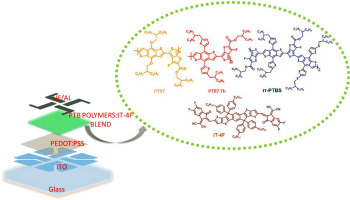Effect of molecular structure of benzo[1,2-b:4,5-b′]dithiophene-based push-pull type donor polymers on performance panchromatic organic photodiodes
- 저자
- Henry Opoku, Chinna Bathula, Eun-Sol Shin, Dang Xuan Long, Hoyoul Kong, Yu Jin Jung, Bogyu Lim*, Yong-Young Noh*
- 저널명
- Organic Electronics, 78, 105580 (2020)
- 년도
- 2020
- Link
- https://doi.org/10.1016/j.orgel.2019.105580 341회 연결
[Abstract]
Herein, the molecular structure variation effect in well-known PTB polymer series based on the performance of organic photodiode (OPD) is explained. PTB7, PTB7-Th, and rr-PTBS polymers, which comprise of the same molecular structure as thieno[3,4-b]thiophene (TT) and benzo[1,2-b:4,5-b′]dithiophene (BDT) but distinct structural alterations, are used as donor moieties with 3,9-bis(2-methylene-((3-(1,1-dicyanomethylene)-6,7-difluoro)-indanone))-5,5,11,11-tetrakis(4-hexylphenyl)-dithieno[2,3-d:2′,3′-d’]-s-indaceno[1,2-b:5,6-b’]dithiophene (IT-4F) as a non-fullerene acceptor for the bulk heterojunction OPD active layer. Panchromatic spectra response at a broad spectrum from 300 to 900 nm was observed in the OPDs with the above-mentioned combination. The bulk heterojunction conventional OPD based on a relatively thin rr-PTBS:IT-4F active layer with 3 v/v% of 1,8-diiodooctane additive at a wavelength of 600 nm (red light region) showed superior performance with the highest specific detectivity in the range of ~1012 Jones, an average responsivity of 312.94 mA/W and EQE of ~73% at −2 V. In this study, a stronger lamellar stacking and a much-pronounced face-on orientation with enhanced morphology of rr-PTB:IT-4F blend film is ascribed to its superior device performance compared to others.
